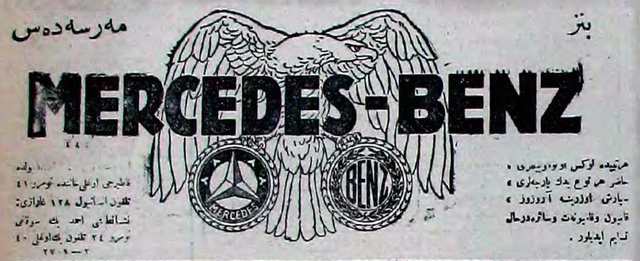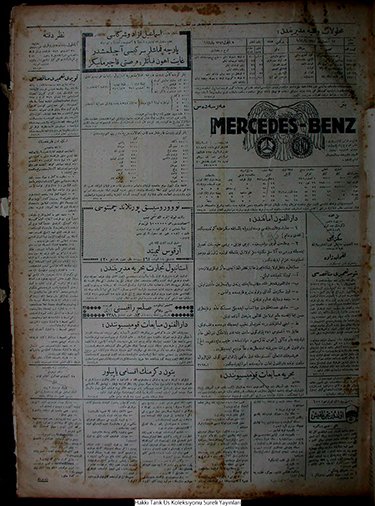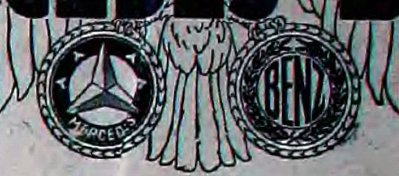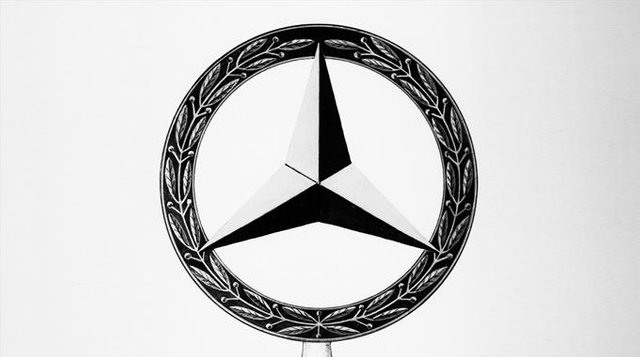104. Today in 1920s Turkey: 13 August 1925 (Early “Mercedes-Benz” Advertisement)

(Mercedes-Benz Advertisement, Cumhuriyet or “Republic,” August 1925.)
Türkçe:
Mercedes-Benz
Her tipte lüks otomobilleri,
Hazır her nevi yedek parçaları,
Sipariş üzerine [آروزوز],
Kamyon ve kamyonet vesaire derhal teslim ediliyor.
English:
Mercedes-Benz
Luxury automobiles of every type,
Every kind of replacement parts available,
[آروزوز] by order,
Trucks and vans etc. are delivered immediately.
Comments
Mercedes (then Daimler Motor Companies, DMG) and Benz officially merged in 1926. The two automotive companies, however, began working together in the years leading up to this joint partnership (mbca.org). This is why it is possible to find advertisements for “Mercedes-Benz” a year earlier, in 1925.
The present advertisement is one of several that were featured in the daily newspaper Cumhuriyet or “Republic” in Turkey in August 1925 with different versions running in the following months. With roughly 1/12 of the newspaper’s page occupied, this advertisement is one of the largest and more arresting ads in that day’s issue.

(Entire page, Cumhuriyet or “Republic,” 13 August 1925, no. 453- page 7.)
The symmetrical composition consists of the Latin-letter words MERCEDES-BENZ superimposed upon an eagle with its wings spread open. Beneath the text, the eagle’s talons each rest on one of two medallions. As the text within each roundel suggests, they are the brand emblems for the two companies Mercedes, and Benz held together by the claws of a raptor.

According to the official Mercedes-Benz (museum/history) website, the modern trademark is an amalgamation of elements from these two emblems: the iconic three-pointed star (Mercedes) and the circular laurel wreath (Benz).
The Latin text used for the brand name is, of course, accompanied by Ottoman Turkish text. Firstly, the words floating somewhat independently in the upper left and right corners merely transcribe the words “Mercedes” (مه رسه ده س) and “Benz” (بنز) above the corresponding Latin words. Further information about the product is provided in two brief text blocks in the lower right and left corners. In the right corner are the words provided in the translation above whereas the text in the left corner lists contact information (address, phone number).
Something that should immediately strike an observant viewer is the blatant lack of a visible automobile in the ad. Large words, bold fonts, and imagery are what attract the reader’s attention to one advertisement and not another. So what visual “cues” does this advertisement rely on if not an image of their sleek product, the holy grail of 1920s consumerism, the automobile? Well, in this case it is possible to make the argument that Mercedes and Benz, as long established companies, already enjoyed (well-deserved) name and brand-recognition in places like Turkey. Both the Latin words for the brand and their trademarks were considered recognizable enough to act as stand-ins to the actual products they are attempting to sell.
Personally, I am not amazed by the fact that brand recognition or ubiquity itself can sell products, modern life demonstrates this concept to us ad nauseam (e.g. Apple, Disney, Starbucks etc). What amazes me is how quickly it spreads and how early this begins. While this is not the first Mercedes-Benz advertisement of this era, it is one in a chain of many that built the longstanding popular obsession with luxury items like the Mercedes automobile in places like Turkey.

Çok güzel bir seri yapmışsınız. Devamını dilerim. Kolay gelsin!
Teşekkür ettim, beğendiğinize sevindim!
great work keep it up .. :)
Thank you. Upvote if you like it.
This post has been modified, updated, and re-posted on 13 August 2018. Access the new edition here.